From Wikipedia, the free encyclopedia
| PAK FA | |
|---|---|
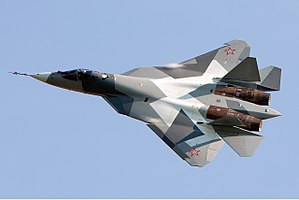 |
|
| PAK FA T-50 | |
| Role | Stealth multirole fighter |
| National origin | Russia |
| Manufacturer | Sukhoi |
| First flight | 29 January 2010[1] |
| Introduction | 2016[2] |
| Status | Test flight/pre-production |
| Primary users | Russian Air Force Russian Navy[3] |
| Number built | 5 prototypes[4] |
| Program cost | US$8–10 billion (est.)[5][6][7] |
| Unit cost | |
| Variants | Sukhoi/HAL FGFA |
The PAK FA, a fifth generation jet fighter, is intended to be the successor to the MiG-29 and Su-27 in the Russian inventory and serve as the basis of the Sukhoi/HAL FGFA being developed with India.[11][12] The T-50 prototype performed its first flight 29 January 2010.
The Russian Defence Ministry will purchase the first 10 evaluation example aircraft after 2012 and then 60 production standard aircraft after 2016.[13][14][15] The first batch of fighters will be delivered with current technology engines. The PAK-FA is expected to have a service life of about 30–35 years.[16]
Development
Origins
In the late 1980s, the Soviet Union outlined a need for a next-generation aircraft to replace its MiG-29s and Su-27s in front line service. Two projects were proposed to meet this need – the Sukhoi Su-47 and the Mikoyan Project 1.44. In 2002, Sukhoi was chosen to lead the design for the new combat aircraft.[17] The Novosibirsk Aircraft Production Association is manufacturing the new multirole fighter at Komsomol'sk-on-Amur along with Komsomolsk-on-Amur Aircraft Production Association. Final assembly is to take place at Komsomol'sk-on-Amur.[citation needed]The Tekhnokompleks Scientific and Production Center, Ramenskoye Instrument Building Design Bureau, the Tikhomirov Scientific Research Institute of Instrument Design, the Ural Optical and Mechanical Plant (Yekaterinburg), the Polet firm (Nizhny Novgorod) and the Central Scientific Research Radio Engineering Institute (Moscow) were pronounced winners in the competition held in early 2003 for the development of the avionics suite. NPO Saturn is the lead contractor for the engines.[citation needed]
In 2007, Russia and India agreed to jointly develop the Fifth Generation Fighter Aircraft Programme (FGFA) for India.[18][19][20] In September 2010, it was reported that India and Russia had agreed on a preliminary design contract where each country invests $6 billion; development of the FGFA fighter was expected to take 8–10 years.[21] The agreement on the preliminary design was to be signed in December 2010.[22]
On 8 August 2007, Russian Air Force Commander-in-Chief (CinC) Alexander Zelin was quoted by Russian news agencies that the development stage of the PAK FA program was complete and construction of the first aircraft for flight testing would begin.[23] Zelin also said that by 2009 there would be three fifth-generation aircraft ready. "All of them are currently undergoing tests and are more or less ready," he said.[24] In mid-2009 the design was approved.[17]
Flight testing
The T-50's maiden flight had been repeatedly postponed since early 2007 as the aircraft encountered unspecified technical problems. Alexander Zelin admitted as recently as August 2009 that problems with the engine and in technical research remained unsolved.[25] On 28 February 2009, Mikhail Pogosyan announced that the airframe for the aircraft was almost finished and that the first prototype should be ready by August 2009.[26] On 20 August 2009, Pogosyan said that the first flight would be by year's end. Konstantin Makiyenko, deputy head of the Moscow-based Centre for Analysis of Strategies and Technologies said that "even with delays", the aircraft would likely make its first flight by January or February, adding that it would take five to ten years for commercial production.[27]On 8 December 2009, Deputy Prime Minister Sergei Ivanov announced that the first trials with the fifth-generation aircraft would begin in 2010.[28] The first taxi test was successfully completed on 24 December 2009.[29][30][31] Piloted by Hero of the Russian Federation Sergey Bogdan, the aircraft's 47-minute maiden flight took place on 29 January 2010 at KnAAPO's Dzemgi Airport in the Russian Far East.[32][33][34][35] By 31 August 2010, it had made 17 flights and by mid-November, 40 flights in total.
The second T-50 was to start its flight test by the end of 2010, but this was delayed until early 2011.[36][37][38][39][40] On 3 March 2011, the second aircraft completed a 44-minute test flight.[36] These first two aircraft will lack radar and weapon control systems. The third and fourth aircraft, to be added in 2011, will be fully functional test aircraft.[41] On 14 March 2011, the aircraft achieved supersonic flight at a test range near Komsomolsk-on-Amur.[42]
The T-50 was displayed publicly for the first time at the 2011 MAKS Airshow. Russian Prime Minister Vladimir Putin was in attendance.[43][44] In June 2011, an unauthorized video was made of the Sukhoi PAK FA in flight displaying a variety of aerobatic moves.[45] On 3 November 2011, the PAK FA program achieved its 100th flight.[46] More than 20 test flights were made in the next nine months.[47]
The third prototype, T-50-3, was the first prototype to fly with an AESA radar. Originally scheduled for the end of 2011, these flights occurred in August 2012, and showed performance comparable to existing radars.[48][49] On 22 November 2011, T-50-3 took its first flight from KnAAPO's airfield in Komsomolsk-on-Amur, piloted by Sergey Bogdan. The aircraft spent over an hour in the air, and was subjected to basic stability and powerplant checks.[50] It differs from the other prototypes in the way it lacks a pitot tube. All 14 test aircraft are scheduled to fly by 2015.[51]
The fourth prototype had its first flight on 12 December 2012[52] and joined the other three aircraft in testing near Moscow a month later.[53][54] The fifth prototype had its first flight on 27 October 2013; with this flight the program has amassed more than 450 flights.[55] The first aircraft for State testing was delivered on 21 February 2014.[56]
Design
Overview
Although most information about the PAK FA is classified, sources within in the Russian Air Force and Defense Ministry have openly stated that it features stealth technology and has the capability to supercruise,[6] and incorporate advanced avionics such as an Active Electronically Scanned Array (AESA) radar and an artificial intelligence system.[57] It is to be outfitted with the next generation of air-to-air, air-to-surface, and air-to-ship missiles.[58]The T-50 has a blended wing-body design and incorporates all-moving vertical stabilizers and horizontal elevators. The aircraft has wing leading-edge devices above the jet engine (LEVCONs) designed to control vortices generated by the leading edge for improved behaviour at high AOA. The two engines incorporate 3D thrust vectoring (TVC) nozzles canted at an angle, similar to the configuration on the Su-35S. Differential actuation of these nozzles can produce rolling and yawing moments. The aircraft inlet incorporates variable intake ramps for increased supersonic engine efficiency and retractable mesh screens to prevent foreign object debris from being ingested into the engines.[59]
Composites are used extensively on the T-50 and comprise 25% of its weight and almost 70% of the outer surface.[41] Weapons are housed in two tandem missile bays, each estimated to be between 4.6-4.7 m long. The main bays are augmented by bulged, triangular-section bays near the wing root.[60]
Stealth
The T-50 will be the first operational stealth aircraft in Russian service. Similar to Western stealth fighters like the F-22, the airframe incorporates planform alignment in its leading and trailing edges and sawtooth edges for its skin panels.[61] The serpentine inlet obscures most, but not all, of the compressor face of the engine. The production aircraft will incorporate radar blockers similar in principle to that of the F/A-18E/F to hide the compressor face from all angles. The T-50's stealthy features are most apparent in the forward hemisphere; the shaping of the aft fuselage is much less conducive to radar stealth.[59] The production T-50 is estimated to have reduced the radar cross-section to that of a tennis ball from optimal angles.[62]Avionics
The T-50's avionics consists of the Sh121 multifunctional integrated radio electronic system (MIRES) and the 101KS Atoll electro-optical system.[63] The Sh121 consists of the N036 Byelka radar complex and L402 Himaraya electronic countermeasures system. The N036 Byelka radar complex is developed by Tikhomirov NIIP Institute and consists of a main nose-mounted X-band AESA radar with 1526 T/R modules, designated the N036-1-01,[61] and two smaller L-band AESA radars with 358 T/R modules mounted on the sides of the forward fuselage designated N036B-1-01. The suite also has two N036L-1-01 L-band arrays on the wing's leading edge extensions that are not only used for friend-or-foe identification but also for ground and aerial target detection. Computer processing of the X- and L-band signals enable the system’s information to be significantly enhanced.[64]The radar will reduce pilot load and make use of a new data link to share information between aircraft.[65] In 2012 ground tests began on the third aircraft of the Tikhomirov Scientific Research Institute of Instrument Design's AESA radar.[66] The L402 Himaraya electronic countermeasures (ECM) suite made by the KNIRTI institute uses both its own arrays and that of the N036 Byelka radar. One of its arrays is mounted in the dorsal sting between the two engines.[67]
The 101KS Atoll electro-optical system includes the 101KS-V infra-red search and track mounted on the starboard side in front of the cockpit. This sensor can detect, identify, and track multiple airborne targets simultaneously.[61] The 101KS-O is mounted on a turret in the dorsal spine and has a laser-based countermeasure against heat-seaking missiles. The complex will also include the 101KS-U ultraviolet warning sensors and 101KS-N navigation and targeting pod.[68]
-
-
101KS-V (OLS-50M) infra-red search and track
-
Cockpit
The T-50 has a glass cockpit with two large main multi-functional displays similar in appearance to that of the Su-35S and the F-35. The cockpit has a wide head-up display (HUD).[69] Life support systems will enable pilots to perform 9-g maneuvers for up to 30 seconds at a time. New pressure suits will allow safe ejection at altitudes of up to 23 km.[70]Armament
The PAK FA has a reported maximum weapons load of 7,500 kg.[71] It has an apparent provision for a cannon (most likely GSh-301).[16] The PAK FA has two internal bays estimated at 4.6-4.7 metres by 1-1.1 metres.[72] The expected initial armaments include Kh-35UE (AS-20 "Kayak"), Kh-38ME, Kh-58UShKE (AS-11 "Kilter"), and RVV-MD (AA-11 "Archer") missiles.[73]Two Izdeliye 810 Extended beyond visual range missiles per weapons bay. Multiple Izdeliye 180 / K-77M beyond visual range missiles. K-74 and K-30 within visual range missiles can also be carried.[72] Two KH38M or KH58 USHK air-to-ground missiles per weapons bay. Multiple 250–500 kg precision guided bombs per weapons bay,[72] with a maximum of 10 bombs in internal bays.[71] Other possible loads include one 1,500 kg bomb per weapons bay or two 400 km+ range anti-AWACS weapons (such as the RVV-BD) on external hardpoints.[74][75]
PAK FA chief designer Alexander Davydenko has said that there is a possibility of the installation of BrahMos supersonic missile on the PAK FA and its FGFA derivative. However, it is unclear how these missiles will be installed, though it can be one or two missiles only due to heavy weight of the BrahMos.[76]
Engines
Pre-production and initial serial production models of the T-50 will use first stage engines, a pair of Izdeliye 117 (AL-41F1).[77] The engine is a highly improved variant of the AL-31, and features an increased diameter fan, new high and low pressure turbines, and a digital control system (FADEC). According to Sukhoi director Mikhail Pogosyan, the 117 is a new fifth generation engine built specifically for the PAK-FA. Though the specifics of the new engine remain classified, information provided has included: increased engine thrust by 2.5 tonnes over the AL-31 engine, a reduction in engine weight by 150 kilograms (330 lb). These changes allow the aircraft to supercruise, sustaining supersonic flight speeds without using afterburners.[78] Mikhail Pogosyan further mentioned that the 117 engine meets most of the Russian Air Force's requirements and will be installed on initial production PAK-FA aircraft.[78] The engine produces 21,000 lbs (93.1 kN) of dry thrust, 33,000 lbs (147 kN) of thrust in afterburner, and has a dry weight of 1420 kilogram and a thrust to weight ratio of 10.5:1.[79]In addition to increased thrust compared to its predecessors, the engine has a complex automation system to facilitate maneuverability and handling. Each nozzle has 2-D thrust vectoring canted at an angle to enable the T-50 to produce thrust vectoring moments in all three directional axes, pitch, yaw and roll. These engines will incorporate infrared and RCS reduction measures.[80][81]
Production T-50 from 2020 onwards will be equipped with a more powerful engine known as the Izdeliye 30, which will be a clean sheet design. The engine will have increased thrust and fuel efficiency as compared to 117.[79] The powerplant is being designed to have 30% lower specific weight than the 117 and a thrust of about 107 kN of dry thrust and 176 kN in full afterburner. Development began in 2011 and the engine is planned to be bench tested starting in 2014.[82]
Operational history

PAK FA compressor stall at MAKS-2011
In March 2013, the first aircraft is to be delivered for two years of state trials.[85][86] As of June 2012, construction of modernized testing facilities and a new runway to accommodate the next phase of the PAK FA program is underway at the 929th State Flight Test Center in Akhtubinsk.[87][88]
On 6 August 2013, the Russian Air Force announced they will take delivery of their first T-50 "in the third quarter of this year," with final state test flights starting in the fourth quarter. The aircraft will enter service in 2016.[89]
Exports
Sukhoi states that the main export advantage of the PAK FA is its lower cost than current US fifth generation jet fighters.[90] Russia was reported to be offering the PAK FA for South Korea's next generation jet fighter.[91] South Korea's defence procurement agency confirmed that the Sukhoi PAK FA was a candidate for the Republic of Korea Air Force's next-generation fighter (F-X Phase 3) aircraft;[92] however, Sukhoi did not submit a bid by the January 2012 deadline.[93]Russia's Centre for Analysis of World Arms Trade predicts that the PAK FA will be available for export in 2025;[94] though this may include the Sukhoi/HAL FGFA for India,[95] the primary export version.[96]
Ruslan Pukhov, director of the Centre for Analysis of Strategies and Technologies, has projected that Vietnam will be the second export customer for the fighter.[97]
In 2012, Russian Defense Minister Anatoly Serdyukov said that Russia and India would jointly build the export version of the T-50 starting in 2020.[98] In 2013, United Aircraft Corporation president Mikhail Pogosyan said that the Russian PAK FA and the Sukhoi/HAL FGFA will use the "identical onboard systems and avionics".[99]
In 2013, Russia made an unsolicited call for Brazil to help in developing a next-generation fighter based on the T-50.[100][101]
Variants
FGFA
Main article: Sukhoi/HAL FGFA
The completed joint Indian/Russian versions of the single-seat or
two-seat FGFA will differ from the current T-50 flying prototypes in 43
ways with improvements to stealth, supercruise, sensors, networking, and
combat avionics.[102]In March 2010, Sukhoi director Mikhail Pogosyan projected a market for 1,000 fighter aircraft over the next four decades, which will be produced in a joint venture with India, 200 each for Russia and India and 600 for other countries.[103] He has also said that the Indian contribution would be in the form of joint work under the current agreement rather than as a joint venture.[104] In June 2010, the Indian Air Force planned to receive 50 of the single-seat "Russian version" before receiving the two-seat FGFA.[105] Then in an October 2012 interview the Chief of Air Staff of India, NAK Browne, said that the IAF will purchase 144 of the single-seat FGFA. In order to reduce development costs and timelines, the IAF plans to begin induction of the FGFA in 2020.[106]
Navalized Sukhoi T-50 PAK FAs will be deployed on the Russian aircraft carrier Admiral Kuznetsov and future Russian aircraft carriers.[107] There will be a competition between the Sukhoi, Mikoyan and Yakovlev design bureaus to choose the new naval aircraft.[3]
Alexei Fedorov has said that any decision on applying fifth-generation technologies to produce a smaller fighter (comparative to the F-35) must wait until after the heavy fighter, based on the T-50, is completed.[108]
UCAV
On 30 August 2013, the United Aircraft Corporation said they were developing an unmanned combat air vehicle based on the T-50 fighter. The drone is currently at a preliminary research stage. Once the fundamental specifications are agreed upon, creating it should be simple with the technology provided by the T-50 program.[109] The UCAV version will weigh 20 tons and is expected to be unveiled in 2018.[110]Specifications
Because the aircraft is in development, these specifications are preliminary and are taken as estimates from the available images.General characteristics
- Crew: 1
- Length: 19.8 m (65.9 ft)
- Wingspan: 14 m (46.6 ft)
- Height: 6.05 m (19.8 ft)
- Wing area: 78.8 m2 (848.1 ft2)
- Empty weight: 18,500 kg (40,785 lb)
- Loaded weight: 29,772 kg[N 1] (65,636 lb)
- Useful load: 7,500 kg (combat load) (16,534 lb)
- Max. takeoff weight: 37,000 kg (81,570 lb)
- Powerplant: 2 × Izdeliye 117 (AL-41F1) for initial production, Izdeliye 30 for later production[79] thrust vectoring turbofan
- Dry thrust: 93.1 kN (21,000 lbf) each
- Thrust with afterburner: 147 kN (33,047 lbf) each
- Fuel capacity: 10,300 kg (22,711 lb)[111]
- Maximum speed: Mach 2+ (2,135 km/h, 1,327 mph)
- Cruise speed: 1,300-1,800 km/h[113] (808-1,118 mph)
- Ferry range: 5,500 km[114] (3,417 mi)
- Service ceiling: 20,000 m (65,000 ft)
- Rate of climb: 350 m/s (68,900 ft/min[115][116])
- Wing loading: 330-470 kg/m2 (67-96 lb/ft2)
- Thrust/weight: 1.01 (1.20 for new engines)
- Maximum g-load: 9 g[70]
- Guns: None on prototype. Apparent provision for a cannon (most likely GSh-301).
- Hardpoints: Currently 6 internal hardpoints and up to 6 external hardpoints: two internal bays running longitudinally on the fuselage supporting a total of 4 RVV-BD AAMs (R-37 derived), plus 2 small internal wing bays for 2 RVV-SD AAMs and up to six external hardpoints.[117]
- Sh121 multifunctional integrated radio electronic system (MIRES)
- N036 Byelka radar built by Tikhomirov NIIP
- Main X-band N036-1-01 AESA radar with 1522 T/R modules
- 2 Side facing X-band N036B-1-01 AESA radars with 358 T/R modules each, to increase angular coverage
- 2 L-band N036L-1-01 arrays on the Leading-edge extension for IFF functionality
- L402 Himaraya ECM suite built by KNIRTI institute
- N036 Byelka radar built by Tikhomirov NIIP
- 101KS Atoll electro-optical suite[61]
- 101KS-O: Laser-based countermeasures against infrared missiles
- 101KS-V: IRST for airborne targets
- 101KS-U: Ultraviolet warning sensors
- 101KS-N: Targeting pod
See also
- Related development
- Aircraft of comparable role, configuration and era
- Related lists
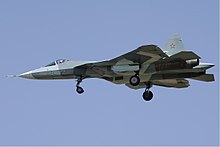
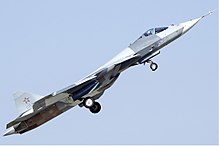

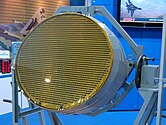

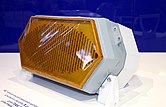
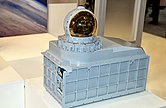


No comments:
Post a Comment